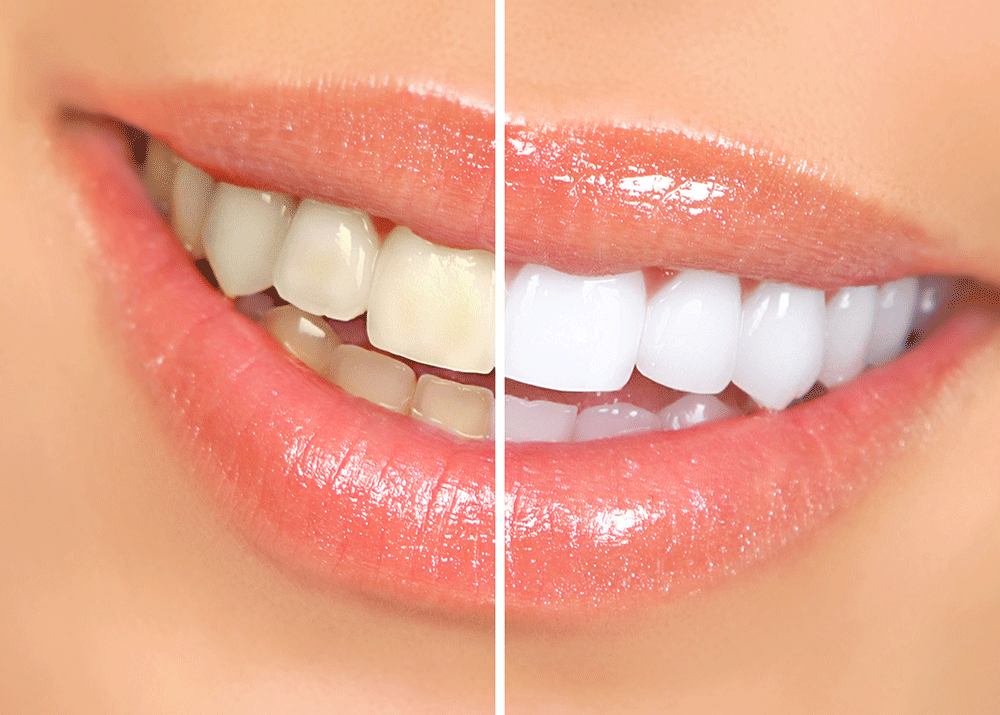- Understanding Teeth Whitening
Teeth whitening is a common cosmetic dental treatment designed to lighten the shade of your natural teeth. It works by applying bleaching agents—typically hydrogen peroxide or carbamide peroxide—that penetrate enamel to break down colored molecules, leaving your teeth visibly brighter. There are several whitening options, ranging from professional in-office treatments to DIY methods.
- Debunking Common Myths
Myth 1: Whitening toothpaste can replace professional whitening
- Reality: Whitening toothpaste usually contains abrasive particles or low-level bleaching agents that can remove surface stains only, potentially whitening by about one shade. But they are far less effective than professional-grade treatments.
Myth 2: Natural remedies like lemon, baking soda, or coconut oil are effective
- Reality:
- Lemon juice is highly acidic (pH ~2) and can erode enamel.
- Baking soda, while mildly abrasive, can wear down enamel over time.
- Coconut oil (“oil pulling”) has no proven whitening efficacy—it may help with oral hygiene but won’t brighten teeth.
Myth 3: Teeth whitening is harmful to enamel
- Reality: When done by a qualified dentist, whitening is safe. Modern bleaching agents properly applied don’t damage enamel. Overuse or incorrect at-home use can cause sensitivity or wear on enamel.
Myth 4: All teeth whitening gives you a “Hollywood white” smile
- Reality: Whitening enhances your natural shade—it typically lightens teeth 3–8 shades, not create unnaturally bright smiles.
Myth 5: Whitening works for crowns, veneers, or fillings
- Reality: Only natural enamel responds to bleaching agents. Dental restorations (e.g., crowns, veneers) won’t change color, possibly producing uneven results.
Myth 6: Results are permanent
- Reality: Whitening fades over time. Lifestyle factors—coffee, wine, smoking—can re-stain teeth. Expect touch-ups approximately every 6–24 months.
Myth 7: Sensitive teeth are a contraindication to whitening
- Reality: Not necessarily. Dentists can adjust treatment plans, use desensitizing agents, and protect gums to minimize discomfort.
Myth 8: UV or LED light is required for whitening
- Reality: Light activation is marketed heavily but isn’t necessary for effective bleaching. It may speed the process slightly, but UV light poses no clear benefit—and carries risks.
3.Fact-Based Insights
3.1 Types of Teeth Whitening Methods
1.In-Office Whitening
Performed by dental professionals, this method uses high-concentration bleaching agents for immediate results.
2.At-Home Whitening Kits
Provided by dentists, these kits include custom-fitted trays and professional-grade whitening gel.
3.Over-the-Counter Products
Available in stores, these include whitening strips, gels, and toothpaste. They offer convenience but are less potent than professional options.
4. Safety & Side Effects
- Temporary sensitivity: 67–78% of patients may experience mild sensitivity for a few days.
- Gum irritation: Can occur if bleaching gel contacts soft tissue—easily avoided with professional guidance.
- Enamel effects: High concentrations can roughen enamel temporarily, but recovery and remineralization occur naturally or with fluoride support.
5. Who Should Wait?
- Children/adolescents: Their tooth structure is still developing—better to wait until early adulthood.
- Pre-existing dental issues: Cavities, gum disease, or worn enamel should be addressed before whitening.
6. Pro Tips for a Bright Smile
- Consult your dentist before starting any whitening.
- Set realistic expectations—discuss achievable shade with your dentist.
- Protect your enamel: Use fluoride toothpaste and follow post-treatment care.
- Control sensitivity: Pre-treat with desensitizing gels (potassium nitrate, sodium fluoride).
- Maintain results: Avoid staining foods/drinks. Touch-up kits can extend whitening life.
- Replace restorations last: Whiten enamel first, then match veneers/crowns later.
Patient Empowerment
- Ask your dentist: “Which method suits my enamel and sensitivity?”
- Understand that results are temporary—touch-ups help sustain brightness.
- Always prioritize oral health—white teeth shouldn’t come at the cost of enamel or gum health.
HOW WE CAN HELP!
AT ORAL MEDICS DENTAL CLINIC and Implant centre offer’s safe, professional-grade teeth whitening that brightens your smile by several shades in just one appointment—far more effectively than over-the-counter kits—and with expert supervision to minimize sensitivity and protect gum tissue. Our treatments not only enhance aesthetics but also help reduce harmful surface bacteria, promote fresher breath, and support healthier teeth and gums right from day one.

